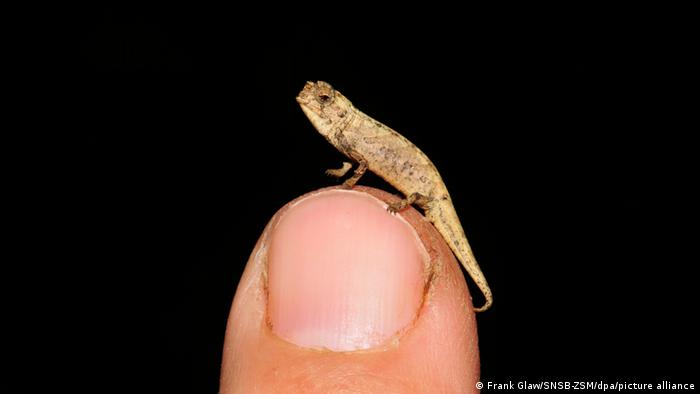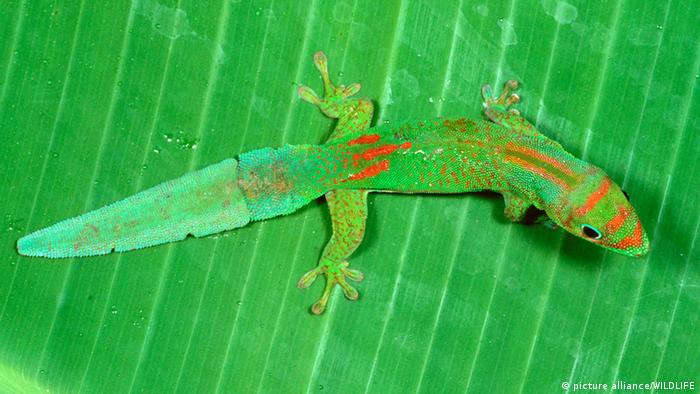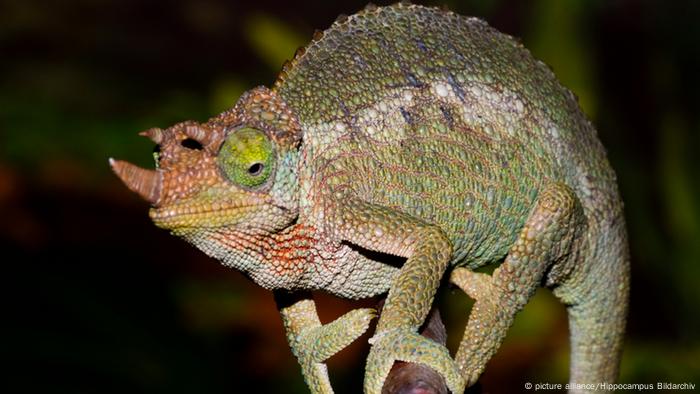
A German vegetable seller discovered a chameleon in a can of cauliflower, local police said on Thursday.
The trader was unpacking vegetables when he made the discovery in Bilsen, in the far north of Germany, 125 kilometers from the Danish border.
He told police the cauliflower had been exported from France.
Police said the chameleon was probably around nine months old and appeared to be in good health.
"When we looked into the box of cauliflowers, two peeping eyes, moving independently of each other, stared at us from the vegetation," a police spokesperson said in a statement.
"The four-legged creature, which presumably originated in Africa, showed no signs of the immense strain of the journey and was received by us in good health," he said.
Officers took the chameleon to a local wildlife sanctuary in Klein Offenseth-Sparrieshoop.
-
The cabinet of reptilian curiosities
Tiny – but a big find
Brookesia nana is the name of the smallest known reptile in the world. It was discovered in January 2021. Its small length of 13.5 to 19 millimeters and its brown coloring make it barely noticeable on the forest floor. The small chameleon lives in a remote part of northern Madagascar. So far this mini reptile is a loner – no other such specimen has yet been found.
-
The cabinet of reptilian curiosities
Perfect camouflage
Have you spotted this mini lizard? With its green color, the small grass-green day gecko barely stands out from the foliage. This genus does not have eyelids. In the course of evolution, the upper and lower eyelids have fused to form a transparent membrane. You are more likely to encounter small animals on islands in the Indian Ocean or in Madagascar.
-
The cabinet of reptilian curiosities
Don't stroke me!
The thorny devil is aptly named: his whole body is covered with thorns. The lizard lives only in Australia. It is perfectly suited to a dry life: the folds of its body carry rain and condensation water directly into its mouth.
-
The cabinet of reptilian curiosities
I'm taller than you think!
This is what the Frilled Lizard (Chlamydosaurus) tries to communicate when it rears its scraps of skin on its neck, threatening predators or rivals. The cutter measures up to 30 centimeters (12 inches) in diameter. Frill-necked lizards belong to the agama family and live exclusively in Australia and New Guinea.
-
The cabinet of reptilian curiosities
A master of colors
Another representative of Madagascar rich in species: panther chameleons are among the most colorful of their species. The color spectrum goes from gray to green, passing through pink and purple. Panther chameleons are known for their crest, which runs the entire length of their back, ending with an extension of the nose.
-
The cabinet of reptilian curiosities
A mini-triceratops
Slightly smaller than its dinosaur counterpart, Jackson's three-horned chameleon measures 38 centimeters (15 inches) in body length. Yet the males of this species are significantly larger than many of its parents. Jackson's Chameleon is native to the rainforests of the mountains of East Africa.
-
The cabinet of reptilian curiosities
A seaweed diver in the Galapagos
The marine iguana of the Galapagos Islands is a remarkable diver. It forages underwater for up to 30 minutes. During this time, his heart rate slows down to ten beats per minute. Her skin is usually dark so she warms up as quickly as possible after swimming in the cold water.
-
The cabinet of reptilian curiosities
Giant dragon
The largest living lizard weighs up to 70 kilograms (154 pounds)! Even deer and wild boar are not too big for the Komodo dragon to stalk them for prey. His secret weapon is his toxic saliva, which reduces blood clotting and can cause shock. The Komodo dragon lives exclusively on the small islands of Indonesia.
-
The cabinet of reptilian curiosities
A lover of good points of view
The green tree python loves to live with a sight. It has a unique habit of wrapping around branches at heights of up to 25 meters (82 feet). Hidden like this, it watches for potential preys. The striking green animals live in northern Australia and New Guinea.
-
The cabinet of reptilian curiosities
Small head – big effect
The common egg-eating snake is an awesome example of how deceptive appearances can be. The skin around its jaw can be stretched up to three to four times its original size. The snake, which is barely as thick as an inch, can even swallow chicken eggs whole. Farmers in sub-Saharan Africa, where the snake hunts its prey, should be careful of them.
-
The cabinet of reptilian curiosities
Camouflaged turtle
At first glance, the appearance of this mata mata seems anything but intentional. But the scraps of skin on the body are ingenious: because of them, the turtle living in the fresh waters of South America appears practically invisible underwater. Any chameleon would be green with envy!
Author: Valentin Betz
Chameleons are mainly found in sub-Saharan Africa and Madagascar, but there are species in southern Europe.
They are popular pets and have become invasive species in some parts of the world. They are known to change the color of their skin to blend in with their surroundings.
French farmers cultivated 218,700 tonnes of cauliflower in 2021, according to industry publications, down slightly due to the cold, a few heat spikes and heavy rains. However, farmers benefited from above average prices due to lower supply. Most of the world's cauliflowers come from China and India.
.











Comments
Post a Comment